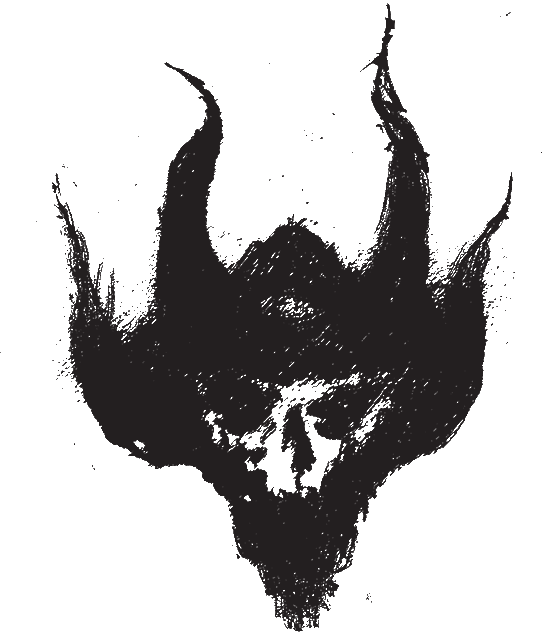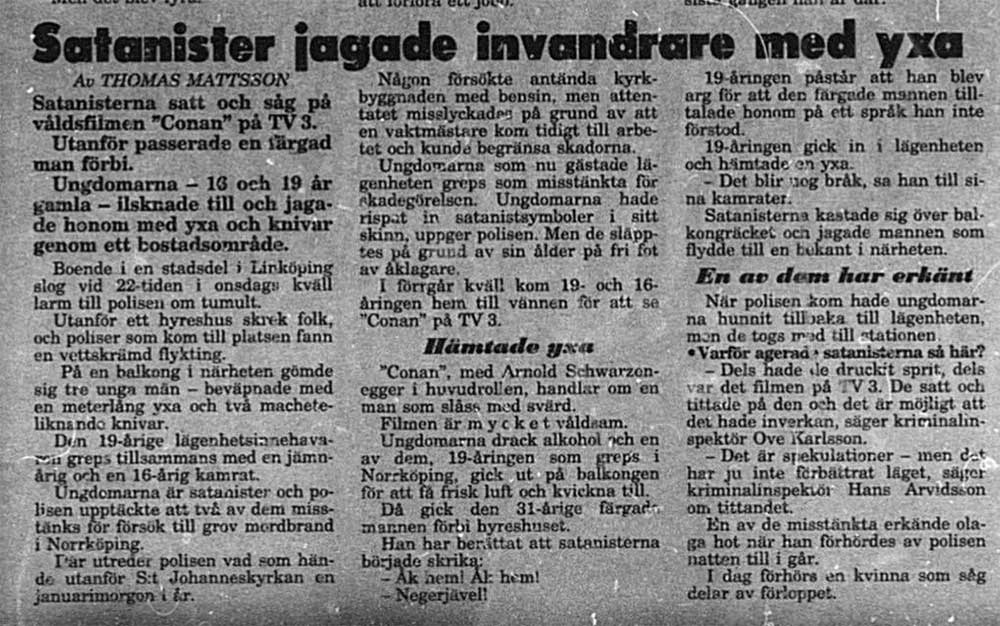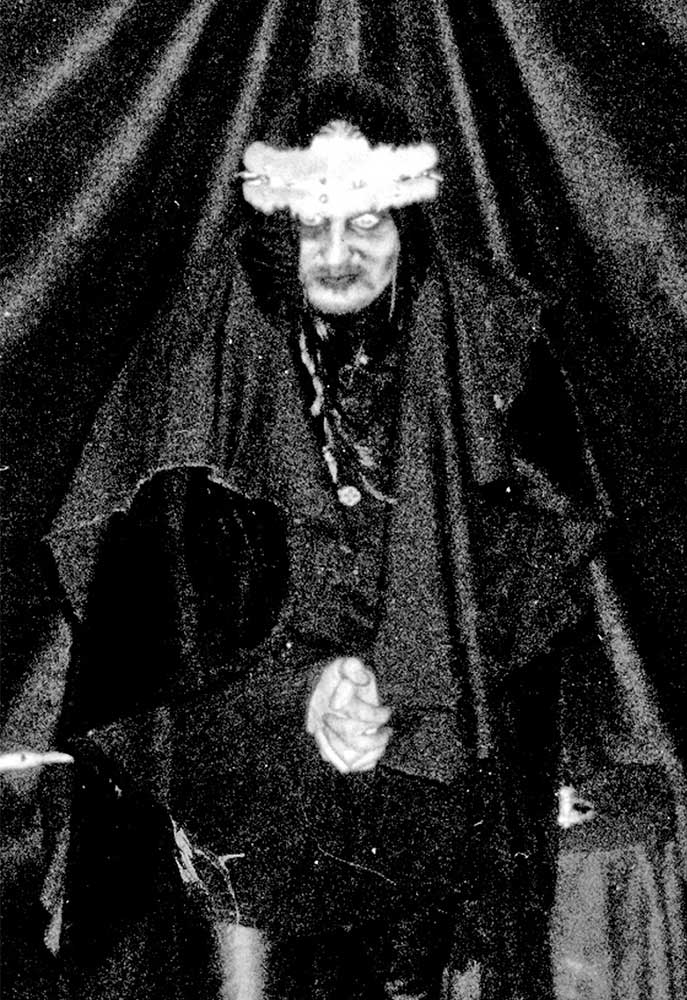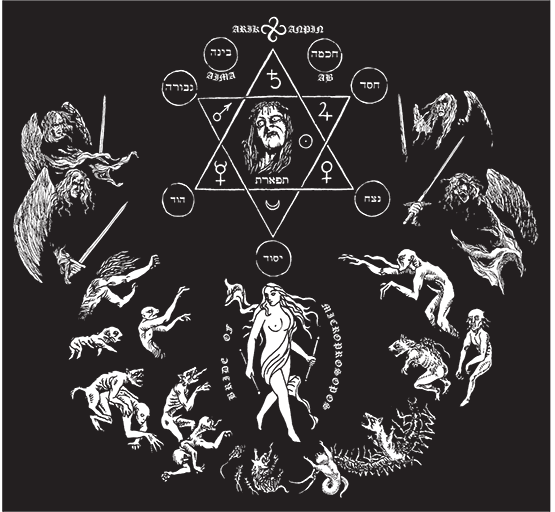Ofermod
2023-08-30
by Niklas Göransson
Discipline of a spirit in pain; Belfagor is the creative force behind Ofermod, the Swedish originators of orthodox religious black metal.
This is an excerpt from the full article, which is twice as long and published in Bardo Methodology #8. The same issue also includes conversations with DESTRÖYER 666/BESTIAL WARLUST, AKHLYS, LEVIATHAN/LURKER OF CHALICE, BLACK WITCHERY, CULTES DES GHOULES, THUNDERBOLT, BLACKDEATH, MISÞYRMING, NORDVIS/ARMAGEDDA, MORTUUS, and DÖDFÖDD/REVERORUM IB MALACHT.

– I was rather shy and withdrawn as a child; it took me a long time to develop this outgoing and gregarious personality. I spoke no Swedish before I started school, so I struggled to make friends. There was a lot of violence in my home, and I had some trouble with the other youths on our block. I grew up in Navestad – a ghetto area full of immigrants. Some Finns, but mostly Turks and Assyrians.
Belfagor was born in Sweden to Finnish parents. Navestad is a district of Norrköping in the Östergötland province, 160 kilometres southwest of Stockholm. At age seven, after an early childhood in relative seclusion, Belfagor began attending an all-Finnish class.
– That in itself made me feel excluded from Swedish society. But it also offered some strength in numbers, as I could form my own little clique of Finnish kids who’d hang out together and get up to all kinds of mischief. We’d gather in big groups – us Finns on one side and Turks on the other – and then fight, bashing each other in the head with rocks and so forth. It was a chaotic upbringing.
Belfagor’s adolescence grew no less turbulent once he found his way to black metal. After being introduced to BLACK SABBATH by his uncle, Belfagor went on to discover first IRON MAIDEN and then VENOM. In the early and mid-90s, Norrköping – as well as nearby Linköping and Finspång – had a vibrant underground metal community. For example, Norrköping hosted the only Swedish date of BLASPHEMY’s Gods of War Tour in March 1993, with local act MARDUK as support.
– I attended that show. The MARDUK members and I were some of the few who stood up front headbanging during BLASPHEMY’s set; almost everyone else left after MARDUK finished playing. But we stuck around and were very impressed by the Canadians. Still to this day, I’m proud to have seen them at such an early stage.
Did you know the MARDUK guys by then?
– Yes, I’d met them the year before, when I was fourteen. Some older Turk at school had taken issue with my inverted crucifix and punched me in the face. A classmate of mine knew MARDUK’s guitarist, Morgan Håkansson, so she brought me to his house. Morgan and Devo agreed to come by the schoolyard as a show of support. Both of them are big guys who were a few years older than us and had a reputation for eating small children, so it was enough that they made an appearance for the Turks to leave me alone.
Later in 1993, Belfagor and two of his friends founded a black metal band called NEFANDUS – a name proposed by Morgan Håkansson. Come summertime of the following year, a sixteen-year-old Belfagor moved into an apartment of his own.
– I didn’t get along with the guy my mother was seeing; there had been a few incidents. For example, I threw a Nintendo game at his face and then whacked him over the head with a vacuum cleaner. I wasn’t allowed to stay after that, so my mother rented an apartment for me. By then, I’d started spending a lot of time with a certain Peter Ståhl in Linköping.
Belfagor’s friendship with Mäster P Ståhl – as he was known back then – would have a monumental impact on both men’s lives. These days, Ståhl is musically active with a Nordic ritual folk project called LEIDUNGR.
– We were introduced by a guy called Simpson – and that was a real character, let me tell you. He earnestly believed himself to be an actual, real-life vampire. I also met people like Henry Möller from PUISSANCE and… you knew Hagström, right?
Jonas Hagström was the proprietor of a small underground label and distro aptly named Violent Nature Productions. VNP released NEFANDUS’ January 1995 “Behold the Hordes” demo tape.
– The first time he and I met, we burglarised a restaurant and stole some beer; that’s how I got to know Hagström. I think this whole mindset of black metal violence took root when I started hanging out with the Linköping crew; we’d be fighting punks and immigrant gangs almost every weekend. I remember one night at McDonald’s; someone punched a key through Hagström’s cheek. He just laughed and began sliding a plastic straw in and out of this gaping hole in his face.

It didn’t take long before Belfagor’s Linköping exploits became national news. In February ‘95, Swedish tabloid Expressen printed a story with the somewhat eye-catching headline ‘Axe-wielding Satanists hunted immigrant’.
– We were at Peter’s place one evening, drinking beer and watching Conan the Barbarian. Simpson suddenly felt nauseous, so he went out for some fresh air and then threw up over the balcony rail. Some black guy walked by outside and started berating Simpson for vomiting on the street; he responded with something about repatriation to Africa, and then everything went quiet. But this guy came back with a few of his friends, so we had to grab two machetes and an axe from the wall and chase them off. But we were probably too fanatical in our pursuit because we charged after them all the way home and then tried to break down their door.
The Expressen story also mentions that two of the young men – who reportedly had satanic symbols carved into their skin – were already under investigation for attempting to burn down a church in Norrköping earlier that year.
– Once we realised that the police were on their way, we ran back to the apartment and hid on the balcony floor – in Simpson’s vomit – for maybe an hour. At first, the cops were just knocking on the door and shining flashlights through the window; then they entered and found us out there, and we started laughing like hell. The constables seemed very perturbed about whom they had arrested. The funny thing is that upon entering the police station, Peter yelled, ‘I am the son of Satan!’
Besides their many tales of marauding, it is perhaps the spiritual aspect of Belfagor and Ståhl’s camaraderie that would leave the greatest mark on black metal history.
– Peter and I developed the early theological side of my devil-worship and started performing black magic rituals. We studied Christian theology, twisting and corrupting everything to fit our worldview. A lot of time was spent reading scripture, which we found both rewarding and formative to our own spirituality. We concluded that the bible must be a creation of the Devil, seeing as how much evil has been perpetrated in its name. And the way we were back then – immature teenagers – we fully embraced such things. Today it would be an entirely different matter.
NEFANDUS’ debut album, “The Nightwinds Carried Our Names”, was recorded in April 1996 and released on Secula Delenda, an underground label and distro operated by Henry Möller of PUISSANCE, the following year. It did not come out as expected, leaving Belfagor gravely disillusioned. Tired of collaborating with mediocre musicians, he decided to start a new project in which he’d handle all instruments himself: OFERMOD. Around the same time, he got to know like-minded musicians from the Stockholm black metal scene.
– I went to the Hultsfred Festival in 1997, and that’s where I first met many of the people from Stockholm bands like MALIGN. Actually, Rostén (FUNERAL MIST) forced me to buy the “Havoc” demo there; he fixed his gaze on me and said, ‘You’ll get the tape for only twenty kronor, so I strongly suggest you buy it.’ I think Sonya was there too – if you remember her? The one who blew her head off with a shotgun.
Sonya Ivarsdotter wrote the lyrics for “Blod skall flöda” from MALIGN’s “Demo 1/95”. She killed herself in January 1999, at twenty years of age.
– I definitely remember running into the guy she was seeing, Magnus. Unbeknownst to me when I first laid eyes on him, this was someone I’d corresponded with by letter for well over a year but never met in person. Rostén and I were just about to bash him for being unworthy of the ABRUPTUM shirt he was wearing when I discovered, ‘Oh, so you’re the fellow I’ve been writing with? I’m Mika – nice to meet you!’

Following the Hultsfred introduction, MALIGN vocalist Nord was invited to join OFERMOD, where he took the name Nebiros. In January 1998, the duo recorded “Mystérion Tés Anomias”: an EP released a few months later on Nebiros’ Pounding Metal Productions. Two years prior, the same label had put out FUNERAL MIST’s “Havoc Demo II ’96”. The back of the OFERMOD seven-inch was adorned by the phrase ‘Orthodox religious black metal’ – a term propagated by Belfagor as he started appearing in both online publications and traditional underground fanzines.
– These interviews are where Peter Ståhl and my ideas began shining through; the things I so desperately wanted to believe in but never truly did, deep down inside. Not the devil-worship itself – my religious conviction was always pure – but all these puerile statements designed to shock and dismay not only so-called normies but ‘normal’ metalheads in particular. It wasn’t really… I mean, we’d watch films like Extreme Torture, Faces of Death, and so on, but I can’t claim to have genuinely enjoyed them; I was only pretending to.
Johannes Kvarnbrink from MORTUUS made an interesting point in that he probably devoured OFERMOD’s early interviews in much the same way as black metal devotees from Belfagor’s generation pored over the words of Euronymous.
– I never considered that at the time. When I first heard people talking about having taken my interviews as some kind of gospel, it felt surreal. My primary ambitions were to scare people away from OFERMOD and keep only the most fanatical lunatics as fans. But it never occurred to me that anyone would be taking these tirades to heart, much less base their worldview on them.
Following the EP recording, Belfagor started spending a lot of time with his new contacts in Stockholm. OFERMOD brought in bass player Mist, who was also in OPHTHALAMIA and MALIGN. Together with a number of cohorts, they founded a religious order called Ordo Tartari Germanitas. Around 1999, Belfagor was working on an OTG manual of sorts, delving into religious devil-worship and satanic rites.
– Nah, this isn’t something I’m going to talk about. That book project didn’t get further than sixty or so pages and I don’t have anything left – all of it was scrapped.
Did you ever establish any kind of spiritual link to what you saw as the Devil?
– Yes, at the age of eighteen I connected with what I now know as Belial. This occurred through ritual acts, but that’s nothing I want to discuss in public either. Nonetheless, ever since, Belial has been present in my life on and off. Now, he is here all the time.
Belfagor’s interviews also heralded the coming of OFERMOD’s debut album, “Mystery of Iniquity (Luciferian Evangelium Cantata)”, due for release on Shadow Records. The year before, the same label released MALIGN’s “Fireborn” EP and FUNERAL MIST’s mini-LP “Devilry”. Shadow Records manager Marcus Tena – the man behind TRIUMPHATOR – is originally from Linköping but relocated to Stockholm and opened a physical record store in 1999.
– Tena used to show up at Hagström’s parties in Linköping; that’s how we first met. He never drank anything but seemed entertained by all the chaos going on around him. We didn’t know each other all that well during the 90s, but I respected him as an individual – which is why OFERMOD signed with Shadow Records.

In October 1999, seventeen-year-old Erik Danielsson organised a MALIGN show in his hometown of Uppsala. The opening acts were Erik’s own band, WATAIN – who had released their “Go Fuck Your Jewish ‘God’” demo tape the year before – and DARK FUNERAL. By then, MALIGN drummer Mörk had replaced Vonda on guitar, so Belfagor stepped in as drummer. The gig lasted only two songs, whereupon Belfagor first kicked an audience member in the head and then punched someone from a support band. Not a bad stage debut.
– Yeah, I’d downed about nine beers before that show. The other guys told me earlier in the evening, ‘Let’s not get too drunk tonight so we can play a good gig’, but it was the exact opposite for me. Not long after that, several of my close confidants advised me to lay off the booze altogether. There were just too many incidents; luckily, few with actual legal consequences but a lot of unnecessary close calls.
Around the turn of the millennium, Belfagor started studying Hermetic Kabbalah – an esoteric tradition disseminated by French 19th -century mystics such as Eliphas Levi and Papus. The first lyric Belfagor wrote in this theme was FUNERAL MIST’s “Across the Qliphoth”. After familiarising himself with hermeticism, he began questioning the theistic Satanism of his youth.
– I realised that occultism holds greater truths than the primitive form of devil-worship I’d so wholeheartedly given myself to. These spiritual experiences from ceremonial magic and meditation practices I’d learned through the Hermetic literature were so strong that they left no room for doubt; I could only acknowledge the discovery of something infinitely more potent.
Can you mention an example?
– Early in my studies, I was experimenting with kabbalistic trance states when I ended up in the sefira of Tipareth. It must’ve taken me six hours to fully return to my senses from that condition of solar consciousness. Finally, I remembered a visualisation technique I’d read about; to find my way back to my body, I began envisioning the planet Mercury, then Venus, and finally the Moon and Earth.
That 1999 MALIGN gig in Uppsala was the last time I saw Belfagor for almost a decade. In the early 2000s, I heard various rumours through the grapevine – everything from Belfagor having taken up martial arts to him becoming a career criminal. I don’t recall being particularly shocked at either, but what did surprise me was that he gave up music.
– Once I’d started socialising with a different clientele, there was much less time for music. I’d also grown almost ashamed of being associated with black metal. Obviously, in the eyes of a hardened criminal, all these ‘controversial’ statements from my early OFERMOD interviews would’ve been utterly laughable. So, it certainly wasn’t something I flaunted when running in such circles.
What about religiosity?
– The magic was still there, in both theory and practice. I’ve always been an avid reader and collector of books and would engage in magical acts and ceremonies and rituals whenever I found time for myself. New acquaintances who visited me were often amused to find my bookshelf full of these strange old tomes they’d never seen anywhere else.
For all of the late 90s, Belfagor was a vocal opponent of drug use. It was therefore with some astonishment I learned from Nebiros that Belfagor had announced plans to try heroin. From memory, that was the last time anyone I knew spoke to him in several years.
– Essentially, it started as a search to feel better, but I soon began taking it more frequently. That’s what made me quit my martial arts practice; I could no longer look my wushu master, or sifu, in the eyes because there was a sign on the wall saying that drug users need not apply. And I respected my sifu so much that I couldn’t keep living the double life of a junkie while simultaneously being a Bruce Lee wannabe.
Predictably, a life of crime combined with a heroin habit and an impulsive nature promptly landed Belfagor under lock and key.
– Prison was no big deal for me. Of course, I felt a bit nervous at first, still being a beginner in the game. When I first arrived, I was going through opiate withdrawal, which is one of the nastiest experiences imaginable. You get physical spasms rippling through your entire body; it is insanely agonising. I’d just lie in bed, drenched in sweat, punching the wall to divert the pain to one place instead of throbbing all over. My cellmate was so scared of me that he went to the guards and demanded to be moved out.
When FUNERAL MIST’s “Salvation” was released in September 2003, it caused quite a stir – which, in turn, drew a lot of interest and attention to the now-dormant OFERMOD.
– I was locked up when “Salvation” came out and hadn’t spoken with anyone from the black metal scene for several years, so I knew nothing about this. I assumed OFERMOD had slipped into obscurity and been forgotten. I was originally supposed to serve four years in prison but managed to commute my sentence to a rehabilitation plan. I moved into a treatment facility owned by Pentecostal Christians in 2004, and that’s when I returned to music. My fingers were itching to play the guitar and create meaningful art again. I was still very much inspired by Hermetic Kabbalah, which is why I introduced that theme to OFERMOD.

This is an excerpt from the full article, which is twice as long and published in Bardo Methodology #8. The same issue also includes conversations with DESTRÖYER 666/BESTIAL WARLUST, AKHLYS, LEVIATHAN/LURKER OF CHALICE, BLACK WITCHERY, CULTES DES GHOULES, THUNDERBOLT, BLACKDEATH, MISÞYRMING, NORDVIS/ARMAGEDDA, MORTUUS, and DÖDFÖDD/REVERORUM IB MALACHT.



